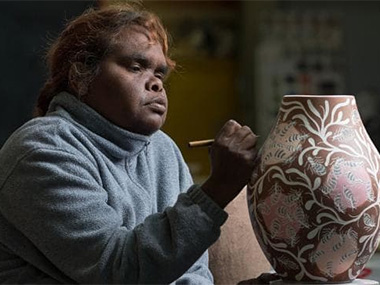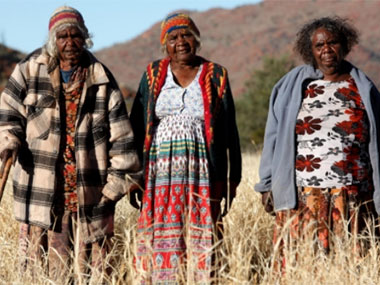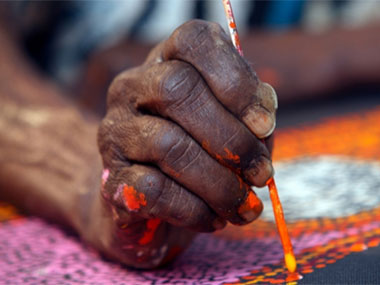Closing the Craft Circle

Artist Lynette Lewis - daughter of the pioneering Atipalku Intjalki - concetrates on the pot at hand
Posted by Jeremy Eccles | 03.10.18
Dates:
05.10.18
: 14.11.18
Location: Australian Design Centre, 101 William Street, Darlinghurst, Sydney
Sturt Gallery and Ernabella Arts present In These HANDS: Mara nyangangka, an exhibition of new paintings, ceramics, tjanpi weavings and punu from the artists of Ernabella, celebrating 70 years of Ernabella Arts – the first of our now many community arts centres. It opens this weekend.
The fruits of a partnership between Australia's two oldest centres for craft and design – Sturt Gallery & Studios (1941) and Ernabella Arts (1948), are the subject of this exhibition, curated jointly by Sturt's Slavica Zivkovic and Ernabella's Alison Milyika Carroll. In 1968, Elisabeth Nagel, who led the Sturt Weaving Studio for 50 years, made her first visit to Ernabella – or Pukatja, as Anangu call it - with a desire to share knowledge of her craft. Subsequently, six young artists from Ernabella in two groups went to Sturt as part of a residency to learn new weaving techniques. One of those women, Atipalku Intjalki, who was just 17, is still alive and enjoyed a 40 year reunion with Nagel at the Sturt Studio earlier this year when this exhibition was first shown.
Nagel, 87, whose works are in collections in the National Gallery of Australia and the National Library, is now retired and still lives near Sturt. “The amount the girls learned in such a short time was staggering,” she told The Australian. “Not just in the weaving but also in the environment they had entered. It was a world away from Ernabella”.
In These HANDS: Mara nyangangka tells the story of that residency, its impact on the generations that followed – Atapalku's daughters Langaliki Lewis and Lynette Lewis have become artists, for instance - and offers a showcase of the contemporary work of senior artists including Pepai Jangala Carroll, Rupert Jack, Tjunkaya Tapaya and Alison Milyika Carroll alongside emerging Indigenous artists.
In These HANDS not only tells the historical story of the link between these two famous centres, it celebrates the long tradition of craft and design in Australia while at the same time being testament to the positive partnership and understanding between Indigenous and non-Indigenous cultural institutions sharing that same passion for ‘making’. Some wall weavings and floor rugs from the early days of the exchange will be on show in the exhibition.
“Our drawings are inside us, they are part of us in the same way we are part of this Country. Everyone works differently but we are all putting down our Country and our stories.
We have strong law and culture, and this tells Anangu how to live. Our ways still remain the same, it never changes. Our law, our culture and the way we live – we would never want any of this to change. It keeps us strong”.
~ Anne Thompson – Ernabella artist
About Ernabella Arts
Established in 1948 by the Presbyterian Church Mission, then developed by the legendary Winifred Hilliard from 1950, Ernabella Arts is Australia’s oldest, continuously running Indigenous Art Centre. Ernabella is at the eastern end of the Musgrave Ranges in the far north west of South Australia.
Pukatja was the first permanent settlement on the Anangu Pitjantjatjara Yankunytjatjara Lands (APY Lands). A craft room was established in 1948, and the first craft products were hand-loomed woven fabrics and hand-pulled and knotted floor rugs with a unique pattern that became known as ‘the Ernabella walka’ or Anapalayaku walka (Ernabella’s design). They were made from the plain fleece wool that the shearing men on what was then a sheep station brought into the craft room for the women to spin.
In recent years, long after starting to work as artists, senior women decided to leave behind the walka of the early days and to depict their Tjukurpa (sacred stories of country and law) in paintings and pottery.
The Centre’s reputation lies in the adaptability and innovation of the artists who have been introduced to many different media since the craft room began. Ernabella Arts is an Aboriginal owned and run corporation which promotes and supports ethical practice in the creation and sale of Indigenous art.
In recent news, Ernabella artist Rachael Mipantjiti Lionel was highly commended in the John Fries Award for her painting Kapi Wankanya (2018)
About Sturt Gallery & Studios
Sturt was founded in 1941 by Winifred West (1881-1971) when she retired as headmistress from Frensham, the independent secondary school for girls she'd established in 1913 in Mittagong.
Interested in the value of relationships between individuals and communities, the links between hand and mind and ‘the development of individual talents and personalities’, Miss West’s intent was to provide further education in crafts, music and drama for children who had left the local primary school, and for adults seeking useful and creative skills.
Sturt started with one building where, at weekends, six girls learned spinning and weaving, while two boys did woodwork nearby and adults came during the week. By 1949, 150 children were enrolled.
Eventually formal workshops were set up: Wood (1947), Weaving (1951), Pottery (1954), Jewellery and Metalwork (1965), Screenprinting (1973), Sturt School for Wood (1985), Design & Fabrication Studios (2014).
Today, Sturt is recognised nationally as a centre of excellence for the promotion, production and teaching of Australian craft and design.
URL: https://australiandesigncentre.com/these-hands-mara-nyangangka/
Share this:
»  del.icio.us
»
del.icio.us
»  Digg it
»
Digg it
»  reddit
»
reddit
»  Google
»
Google
»  StumbleUpon
»
StumbleUpon
»  Technorati
»
Technorati
»  Facebook
Facebook
Contact Details

Pantijiti Lionel, Tjariya (Nungalka) Stanley, Niningka Lewis at homelands near Ernabella. Photo: Alex Craig, Ernabella Arts

The hand of Yurpiya Lionel at work on 'Anumara' (2017), Photo: Alex Craig, Ernabella Arts
Further Research
Artists: | Alison Milyika Carroll | Anne Thompson | Atipalku Intjalki | Langaliki Lewis | Lynette Lewis | Niningka Lewis | Pantijiti Lionel | Pepai Jangala Carroll | Rachael Mipantjiti Lionel | Rupert Jack | Tjariya (Nungalka) Stanley | Tjunkaya Tapaya
News Tags: Australian Design Centre | Elisabeth Nagel | Erabella Art | Jeremy Eccles | Slavica Zivkovic | Sturt Studio | Winifred Hilliard | Winifred West
News Categories: Australia | Blog | Exhibition | Feature | Industry | News
Exhibition Archive
- 10.10.18 | The Aboriginal Memorial – A Smouldering Reproach
- 03.10.18 | Closing the Craft Circle
- 03.10.18 | Quilliam's Blood, Bone, Ascension
- 13.09.18 | SYDNEY CONTEMPORARY 2018
- 03.09.18 | Mawurndjul Makes Headlines in DC
- 23.08.18 | Indigenous Pots Are Hot
- 19.08.18 | CIAF Sets Records
- 16.08.18 | The Politics of Art in Darwin
- 01.08.18 | A SENSE OF PLACE
- 29.06.18 | INTERNATIONAL ACTIVITY
- 24.06.18 | Blak Markets Back in Sydney
- 22.06.18 | “I am the old and the new”
- 08.06.18 | WARS & MASSACRES
- 03.06.18 | NY “Goes Ballistic” over Aboriginal Art
- 24.05.18 | THE LOCKHART BRAND IS BUOYED UP
Advertising

